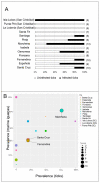Phylogeography and Prevalence of Hemoparasites (Apicomplexa: Eucoccidiorida) in Galápagos Marine Iguanas, Amblyrhynchus cristatus (Reptilia: Iguanidae)
- PMID: 35565568
- PMCID: PMC9105802
- DOI: 10.3390/ani12091142
Phylogeography and Prevalence of Hemoparasites (Apicomplexa: Eucoccidiorida) in Galápagos Marine Iguanas, Amblyrhynchus cristatus (Reptilia: Iguanidae)
Abstract
Parasitism is among the most common forms of coexistence of organisms of different species. Hemoparasites live in the bloodstream of the host where they complete different life-cycle stages. Members of the phylum Apicomplexa constitute a large portion of all hemoparasites infecting reptiles and their parasite transmitting vectors, including arthropods. In this study, we carried out a survey and molecular identification of hemoparasites in blood samples of the iconic Galápagos marine iguana (Amblyrhynchus cristatus). Major island populations of marine iguanas were sampled to examine large-scale biogeographic patterns of parasite diversity and prevalence. Nested PCRs were used to amplify segments of the 18S rRNA-gene of hemoparasites. Furthermore, ticks attached to marine iguanas were collected and analyzed in the same way to assess their potential use as a non-invasive method for the detection of hemoparasites in vertebrate host species. PCR products were sequenced and a phylogenetic analysis was carried out showing the presence of two genetically distinct clusters of hemoparasites, one more commonly distributed than the other one, belonging to the genera Hepatozoon and/or Hemolivia (Apicomplexa: Eucoccidiorida). Overall, 25% of marine iguanas were infected by hemoparasites. However, infection rates varied strongly among particular island populations (from 3.45% to 50%). Although marine iguanas are an extremely mobile species that has colonized all islands in the Galápagos archipelago, parasite occurrence was not related to geographical distance, suggesting that dispersal behavior has a minor role in parasite transmission. On most islands, females tended to have higher infection rates than males, but this relationship was only significant on one island. Overall, ticks and marine iguanas had similar prevalence and diversity of parasites. However, the infection profiles of ticks and their corresponding hosts (marine iguanas) did not mirror one another, indicating that this method cannot be used reliably to assess marine iguana infection status. Interestingly, we found that hemoparasite prevalence in marine iguanas and ticks tended to be positively correlated across islands. Our results indicate that certain populations of marine iguanas may have special mechanisms and adaptations to cope with parasite infection. In addition, other factors such as vector density, anthropogenic-related activities or the immunological state of marine iguanas could potentially affect the striking variation in hemoparasite prevalence across island populations.
Keywords: biogeographic patterns; genetic diversity; hemoparasites; infection status assessment; marine iguanas; prevalence; ticks.
Conflict of interest statement
The authors declare no conflict of interest. The funders had no role in the design of the study; in the collection, analyses, or interpretation of data; in the writing of the manuscript, or in the decision to publish the results.
Figures



Similar articles
-
Diversity of compounds in femoral secretions of Galápagos iguanas (genera: Amblyrhynchus and Conolophus), and their potential role in sexual communication in lek-mating marine iguanas (Amblyrhynchus cristatus).PeerJ. 2017 Aug 17;5:e3689. doi: 10.7717/peerj.3689. eCollection 2017. PeerJ. 2017. PMID: 28828277 Free PMC article.
-
Progressive colonization and restricted gene flow shape island-dependent population structure in Galápagos marine iguanas (Amblyrhynchus cristatus).BMC Evol Biol. 2009 Dec 22;9:297. doi: 10.1186/1471-2148-9-297. BMC Evol Biol. 2009. PMID: 20028547 Free PMC article.
-
The complete mitochondrial genomes of the Galápagos iguanas, Amblyrhynchus cristatus and Conolophus subcristatus.Mitochondrial DNA A DNA Mapp Seq Anal. 2016 Sep;27(5):3699-700. doi: 10.3109/19401736.2015.1079863. Epub 2015 Sep 10. Mitochondrial DNA A DNA Mapp Seq Anal. 2016. PMID: 26357924
-
Targeting ticks for control of selected hemoparasitic diseases of cattle.Vet Parasitol. 1995 Mar;57(1-3):121-51. doi: 10.1016/0304-4017(94)03116-e. Vet Parasitol. 1995. PMID: 7597779 Review.
-
Evolution of body size in Galapagos marine iguanas.Proc Biol Sci. 2005 Oct 7;272(1576):1985-93. doi: 10.1098/rspb.2005.3205. Proc Biol Sci. 2005. PMID: 16191607 Free PMC article. Review.
Cited by
-
First Report of Trypanosoma vivax (Duttonella), Babesia bovis and Babesia bigemina DNA in Cattle from the Galapagos Islands, Ecuador, and Its Relationship with Anaplasma marginale.Pathogens. 2024 Oct 18;13(10):910. doi: 10.3390/pathogens13100910. Pathogens. 2024. PMID: 39452781 Free PMC article.
-
Haematology and plasma biochemistry reference intervals of Galapagos tortoises from Isabela Island.Conserv Physiol. 2025 Jul 29;13(1):coaf054. doi: 10.1093/conphys/coaf054. eCollection 2025. Conserv Physiol. 2025. PMID: 40735306 Free PMC article.
References
-
- Adl S.M., Simpson A.G., Farmer M.A., Andersen R.A., Anderson O.R., Barta J.R., Bowser S.S., Brugerolle G., Fensome R.A., Fredericq S. The new higher level classification of eukaryotes with emphasis on the taxonomy of protists. J. Eukaryot. Microbiol. 2005;52:399–451. doi: 10.1111/j.1550-7408.2005.00053.x. - DOI - PubMed
Grants and funding
LinkOut - more resources
Full Text Sources

